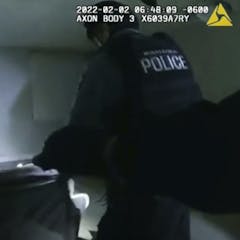
Articles on US police
Displaying 1 - 20 of 85 articles

The type of life and professional experience a police chief has can influence how their departments react to protests, new research finds.

Police thinking of themselves as warriors can lead to distrust and aggression towards minority groups.

Jurors can perceive events in a video in different ways – one of which depends on how the evidence is presented in court, a media scholar explains.

President Biden outlined his achievements in key policy areas and sketched out his plans for the rest of his term in office.

Police departments have faced recruitment and retention problems since the 2020 George Floyd protests. It has meant some agencies have had to lower standards to attract new officers.

The case of Tyre Nichols highlights how traffic stops can turn deadly. Traffic stops are also prone to racial bias, can break down community trust in police and yield few results, research shows.

The officers charged in the murder of a Black man in Memphis, Tenn., were part of the elite SCORPION squad. Such units have an ugly history.

The death of a Black motorist after a beating by five Black Memphis police officers has triggered national outrage over police brutality and systemic racism with the U.S. criminal justice system.

Evidence confirms that minimum-force policing is safer and more effective than the style of policing so colourfully depicted in US crime shows and movies like Die Hard.

Whether crime is up or down depends on what kind of crime, what the comparison is to, and where you’re counting crimes.

A burst of federal funding is letting Indianapolis expand existing efforts and try promising new approaches that other cities have developed.

The death of a 22-year-old man in a ‘no-knock’ raid in Minneapolis has sparked fresh concern over the associated risk to the public and police alike.

At least five people were killed and many more were injured after an SUV crashed into a Christmas parade. A terrorism expert explains how vehicles have been weaponized.

Police body-worn cameras increase disciplinary action against officers and reduce racial bias against citizen complainants, according to a recent study.

FBI statistics recorded a 30% rise in homicides in 2020. A criminologist helps break down what was behind the spike.

Months of bipartisan talks in Congress aimed at reaching consensus over policing reforms have ended with no agreement. Two policing scholars argue that federal efforts are better placed focusing on supporting local measures.

Police body cameras have the potential to make private details about people’s lives, including some of the most stressful experiences of their lives, public and easily accessible online

Sheriffs in less populated counties got bigger boosts from military surplus than sheriffs in more populated counties.

New research confirms that unfair police treatment is psychologically damaging and that the consequences are decidedly worse for certain racial and ethnic groups.

Police officers who kill, injure or violate the rights of citizens are often not held accountable, even in civil court – because in most cases, they can’t be sued for official acts.





